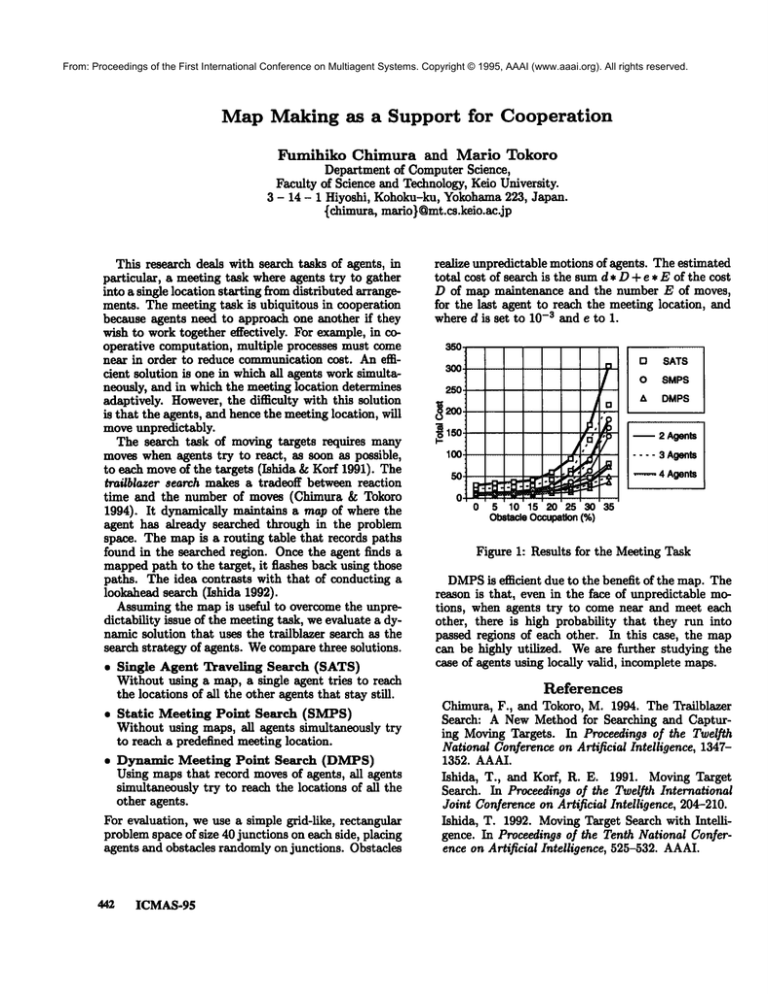
From: Proceedings of the First International Conference on Multiagent Systems. Copyright © 1995, AAAI (www.aaai.org). All rights reserved.
Map Making as a Support for Cooperation
Fumihiko
Chimura and Mario Tokoro
Departmentof ComputerScience,
Faculty of Science and Technology,Keio University.
3 - 14 - 1 Hiyoshi, Kohoku-ku,Yokohama
223, Japan.
{chimura,mario}Gmt.cs.keio.ac.jp
This research deals with search tasks of agents, in
particular, a meeting task whereagents try to gather
into a single location starting fromdistributed arrangements. The meeting task is ubiquitous in cooperation
because agents need to approach one another if they
wishto worktogether effectively. For example,in cooperative computation, multiple processes must come
near in order to reduce communicationcost. Anefficient solution is one in whichall agents worksimultaneously, and in whichthe meeting location determines
adaptively. However,the difficulty with this solution
is that the agents, and hence the meetinglocation, will
moveunpredictably.
The search task of movingtargets requires many
moveswhenagents try to react, as soon as possible,
to each moveof the targets (Ishida & Koff 1991). The
trailblazer search makesa tradeoff betweenreaction
time and the number of moves (Chimura & Tokoro
1994). It dynamically maintains a mapof where the
agent has already searched through in the problem
space. The mapis a routing table that records paths
found in the searched region. Oncethe agent finds a
mappedpath to the target, it flashes back using those
paths. The idea contrasts with that of conducting a
lookaheadsearch (Ishida 1992).
Assumingthe mapis useful to overcomethe unpredictability issue of the meetingtask, weevaluate a dynamicsolution that uses the trailblazer search as the
search strategy of agents. Wecomparethree solutions.
¯ Single Agent Traveling Search (SATS)
Without using a map,a single agent tries to reach
the locations of all the other agentsthat stay still.
¯ Static Meeting Point Search (SMPS)
Without using maps, all agents simultaneously try
to reach a predefined meetinglocation.
¯ Dynamic Meeting Point Search (DMPS)
Using mapsthat record movesof agents, all agents
simultaneouslytry to reach the locations of all the
other agents.
For evaluation, we use a simple grid-like, rectangular
problemspace of size 40 junctions on each side, placing
agents and obstacles randomlyon junctions. Obstacles
442 ICMAS-9$
realize unpredictable motionsof agents. The estimated
total cost of searchis the sumd. D-I- e ¯ E of the cost
D of map maintenance and the number E of moves,
for the last agent to reach the meetinglocation, and
whered is set to 10-s and e to 1.
35O
[]
3OO
/
2.5O
Aa
ID
SATS
O
8MPS
b
DMPS
~
150
2 Agents
100
....
5O
........4 Agents
0
3 Agents
m v ...~.l=..,,-IP-
0
5 10 15 20 253035
Obstacle
Occupation
(%)
Figure 1: Results for the MeetingTask
DMPS
is efficient due to the benefit of the map.The
reason is that, even in the face of unpredictable motions, whenagents try to comenear and meet each
other, there is high probability that they run into
passed regions of each other. In this case, the map
can be highly utilized. Weare further studying the
case of agents using locally valid, incompletemaps.
References
Chimura, F., and Tokoro, M. 1994. The Trailblazer
Search: A NewMethod for Searching and Capturing MovingTargets. In Proceedings of the Twelfth
National Conferenceon Artificial Intelligence, 13471352. AAAI.
Ishida, T., and Koff, R. E. 1991. MovingTarget
Search. In Proceedingsof the Twelfth International
Joint Conferenceon Artificial Intelligence, 204-210.
Ishida, T. 1992. MovingTarget Search with Inteiligence. In Proceedingsof the Tenth National Conference on Artificial Intelligence, 525-532.AAAI.





